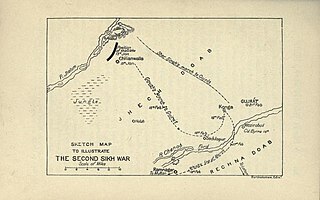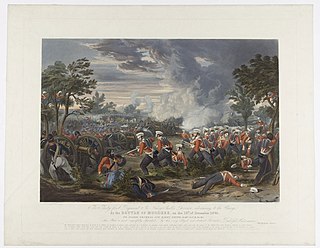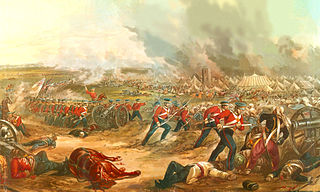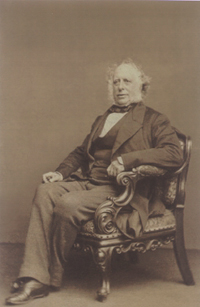
Ranjit Singh was the founder and first maharaja of the Sikh Empire, ruling from 1801 until his death in 1839. He ruled the northwest Indian subcontinent in the early half of the 19th century. He survived smallpox in infancy but lost sight in his left eye. He fought his first battle alongside his father at age 10.

The first Anglo-Sikh war was fought between the Sikh Empire and the British East India Company in 1845 and 1846 around the Ferozepur district of Punjab. It resulted in defeat and partial subjugation of the Sikh empire and cession of Jammu & Kashmir as a separate princely state under British suzerainty.

The second Anglo-Sikh war was a military conflict between the Sikh Empire and the East India Company which took place from 1848 to 1849. It resulted in the fall of the Sikh Empire, and the annexation of the Punjab and what subsequently became the North-West Frontier Province, by the East India Company.

The Sikh Empire was a regional power based in the Punjab region of the Indian subcontinent. It existed from 1799, when Maharaja Ranjit Singh captured Lahore, to 1849, when it was defeated and conquered by the British East India Company in the Second Anglo-Sikh War. It was forged on the foundations of the Khalsa from a collection of autonomous misls. At its peak in the 19th century, the empire extended from Gilgit and Tibet in the north to the deserts of Sindh in the south and from the Khyber Pass in the west to the Sutlej in the east as far as Oudh. It was divided into four provinces: Lahore, which became the Sikh capital; Multan; Peshawar; and Kashmir from 1799 to 1849. Religiously diverse, with an estimated population of 4.5 million in 1831, it was the last major region of the Indian subcontinent to be annexed by the British Empire.

Maharani Jind Kaur was regent of the Sikh Empire from 1843 until 29 March 1847. After the Sikh Empire was dissolved on 29 March 1847 the Sikhs claimed her as the Maharani and successor of Maharaja Duleep Singh. However, on the same day the British took full control and refused to accept the claims.

The Battle of Sobraon was fought on 10 February 1846, between the forces of the East India Company and the Sikh Khalsa Army, the army of the declining Sikh Empire of the Punjab. The Sikhs were completely defeated, making this the decisive battle of the First Anglo-Sikh War.

The Battle of Mudki was fought on 18 December 1845, between the forces of the East India Company and part of the Sikh Khalsa Army, the army of then declining Sikh Empire of the Punjab. The British army won an untidy encounter battle, sustaining heavy casualties.

The Battle of Ferozeshah was fought on 21 December and 22 December 1845 between the British East India Company and the Sikh Empire, at the village of Ferozeshah in Punjab. The British were led by Sir Hugh Gough and Governor-General Sir Henry Hardinge, while the Sikhs were led by Lal Singh. The British emerged victorious.

Majha is a region located in the central parts of the historical Punjab region, currently split between the republics of India and Pakistan. It extends north from the right banks of the river Beas, and reaches as far north as the river Jhelum. People of the Majha region are given the demonym "Mājhī" or "Majhail". Most inhabitants of the region speak the Majhi dialect, which is the basis of the standard register of the Punjabi language. The most populous city in the area is Lahore on the Pakistani side, and Amritsar on the Indian side of the border.

Khalsa College is a historic educational institution in the northern Indian city of Amritsar in the state of Punjab, India. Founded in 1892, the sprawling 300-acre (1.2 km2) campus is located about eight kilometers from the city-center on the Amritsar-Lahore highway, adjoining Guru Nanak Dev University campus, to which Khalsa College is academically affiliated.
Guru Nanak founded the Sikh religion in the Punjab region of the northern part of the Indian subcontinent in the 15th century and opposed many traditional practices like fasting, Upanayana, idolatry, caste system, ascetism, azan, economic materialism, and gender discrimination.
Mahilpur is a city and a Nagar Panchayat in Hoshiarpur district in the Indian state Punjab. It is situated on Hoshiarpur to Garhshankar stretch of State Highway 24. It is famous for the game of football in the region. Mahilpur is connected by road to nearby districts, states and towns such as Jaijon, Jalandhar, Pathankot, Mohali, Chandigarh. Mahilpur is a development block. Mahilpur block has 140 villages in it. It as also known as the soccer-town of India given the craze of football among the people of Mahilpur town and its surrounding villages. It belongs to the Kandi area in the Doaba region of Punjab.Mahilpur had its first bank as Punjab National Bank in 1946 which operates two branches in the city. Mahilpur is famous for mangoes in the region.

The Sikh Khalsa Army, also known as Khalsaji or simply Sikh Army, was the military force of the Sikh Empire. With its roots in the Khalsa founded by Guru Gobind Singh, the army was later modernised on Franco-British principles by Maharaja Ranjit Singh. It was divided in three wings: the Fauj-i-Khas (elites), Fauj-i-Ain and Fauj-i-Be Qawaid (irregulars). Due to the lifelong efforts of the Maharaja and his European officers, it gradually became a prominent fighting force of Asia. Ranjit Singh changed and improved the training and organisation of his army. He reorganized responsibility and set performance standards in logistical efficiency in troop deployment, manoeuvre, and marksmanship. He reformed the staffing to emphasize steady fire over cavalry and guerrilla warfare, improved the equipment and methods of war. The military system of Ranjit Singh combined the best of both old and new ideas. He strengthened the infantry and the artillery. He paid the members of the standing army from treasury, instead of the Mughal method of paying an army with local feudal levies.

Sir Frederick Currie, 1st Baronet was a British diplomat, who had a career in the British East India Company and the Indian Civil Service. His posts included Foreign Secretary to the Government of India, Member of the Supreme Council of India, Resident at Lahore and Chairman of the East India Company.

Akali Phula Singh Nihang was an Akali Nihang Sikh leader. He was a saint soldier of the Khalsa Shaheedan Misl and head of the Budha Dal in the early 19th century. He was also a senior general in the Sikh Khalsa Army and commander of the irregular Nihang of the army. He played a role in uniting Sikh misls in Amritsar. He was not afraid of the British who at many times ordered for his arrest but were not successful. During his later years he served for the Sikh Empire as a direct adviser to Maharaja Ranjit Singh. He remained an army general in many famous Sikh battles up until his martyrdom in the battle of Nowshera. He was admired by the local people and had a great influence over the land and his settlement was always open to help the poor and helpless. He was well known and was a humble unique leader and prestigious warrior with high character. He was also known for his effort to maintain the values of Gurmat and the Khalsa panth.

Raja Lal Singh was Wazir of the Sikh Empire and commander of Sikh Khalsa Army forces during the First Anglo-Sikh War. Along with Tej Singh, Lal Singh is believed to be in the secret employ of the East India Company during the course of the war. Lal Singh was regularly supplying information and even receiving instructions from Company officers, communicating through Captain Peter Nicholson.

The battle of Baddowal was an engagement between the Sikh Khalsa Army and British forces which occurred on 21 January 1846 during the First Anglo-Sikh war. After the Khalsa Army was defeated at the battles of Mudki and Ferozeshah, Ranjodh Singh Majithia led a large Sikh army to attack the British cantonment at Ludhiana. Harry Smith led a column of troops to intercept them, and both armies met at Baddowal but did not engage. Smith's column marched to Ludhiana having suffered several casualties from Sikh artillery and cavalry attacks.
The Nawab of Mamdot was the title of the hereditary rulers of Mamdot, a princely state, near Firozpur, in the Punjab region of British India.
Ilahi Bakhsh was a Muslim Punjabi Arain general who served in the Sikh Khalsa Fauj for over forty years and was regarded as one of the best artillery officers.
François Henri Mouton was a French Army officer. In his early career he served in the Garde du Corps and the Spahis, reaching the rank of captain before being placed on half-pay in 1838.

















